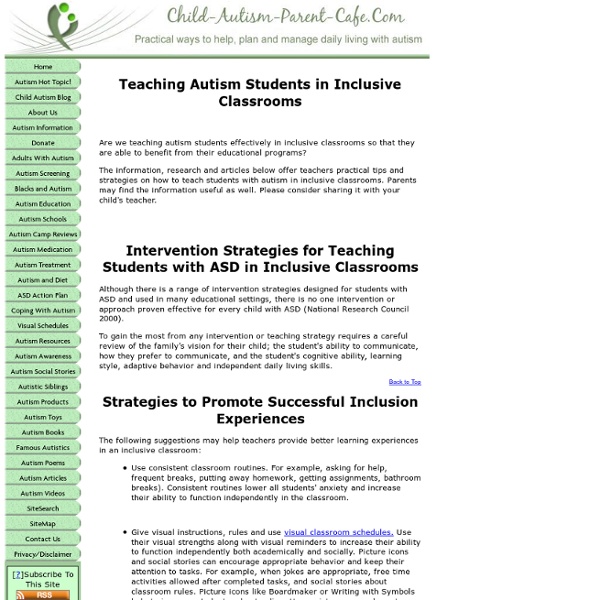Teaching Autism Students in Inclusive Classrooms

http://www.child-autism-parent-cafe.com/autism-students-in-inclusive-classrooms.html
Social Stories for Autistic Students: Understanding and Using Modeling, an Excellent Teaching Tool
One of the central educational issue for autism students (both in the classroom and at home) is a deficit of social skills. Teaching social skills often becomes a primary focus in working with autistic children. Success in teaching social skills can increase self-confidence and and lead to positive result in other areas of the classroom for autistic students. What are Social Stories? Modeling is a powerful teaching strategy with children with some form of autism. A social story is a story that depicts some particular social skill being acted out (or modeled).
Effective strategies for teaching children with autism spectrum disorders - Autism-World
1. Environmental Considerations Visual and auditory stimulation in the classroom must be taken into consideration. Many students with autism are sensitive to auditory input and have a more difficult time processing auditory stimulation. Their work stations should be placed away from excessive auditory stimulation and away from unnecessary movement. 2.
Sites for Autistic Support Teachers!
AdaptedLearning.com A new site from Mayer-Johnson! This site provides an endless amount of Boardmaker files! You must have Boardmaker to open the files.
Free Autism Teaching Resources
We hope that you’ll find our compiled list of Autism related resources useful. We screen them pretty thoroughly, so they are of value; but we can’t endorse them officially. Contact us if you find a broken link or if you would like something posted below! (or taken off) Couldn’t find what you were looking for? Try our Google powered Autism Search system below!
Teaching Strategies
The book “Teaching Infants and Preschoolers with Disabilities”, by Donald B. Bailey and Mark Wolery, suggests 10 intervention strategies to promote learning. These intervention strategies are also applicable to teaching older students.
Pervasive Developmental Disorders Information Page
What are Pervasive Developmental Disorders? The diagnostic category of pervasive developmental disorders (PDD) refers to a group of disorders characterized by delays in the development of socialization and communication skills. Parents may note symptoms as early as infancy, although the typical age of onset is before 3 years of age.
s Resources on Autism Spectrum Disorders and Asperger's
"This web site is dedicated to those individuals who see the world in different ways." Find activities, printables, and interactive games to help students with exceptionalities learn about basics, master organization, and deal with interpersonal challenges on this site. Many of the resources are useful for "regular ed" as well as special ed. Although the site includes items for sale, there are many lesson plans and interactives offered for free.
Students with a Cognitive Impairment - Teaching and Assessment - JCU
Toolkit for Staff Home | Inclusive Teaching Strategies| Appropriate Language | Reasonable Adjustments | Disclosure and Confidentiality | Legislation | University Support Services| FAQ’s | A – Z Index| Students with a cognitive impairment may experience difficulties with various functions of the brain, particularly, short term memory, concentration and planning.Each student has different needs and will require various support mechanisms. This section provides specific strategies to assist and support students with a cognitive impairment.
What is inclusion?
The Index for Inclusion (Booth and Ainscow 2011, 3rd edition) summarises some of the ideas which make up the view of inclusion within the Index as follows: Inclusion in education involves: Putting inclusive values into action.Viewing every life and every death as of equal worth.Supporting everyone to feel that they belong.
Welcome to AutismFitness.com!
Related:


